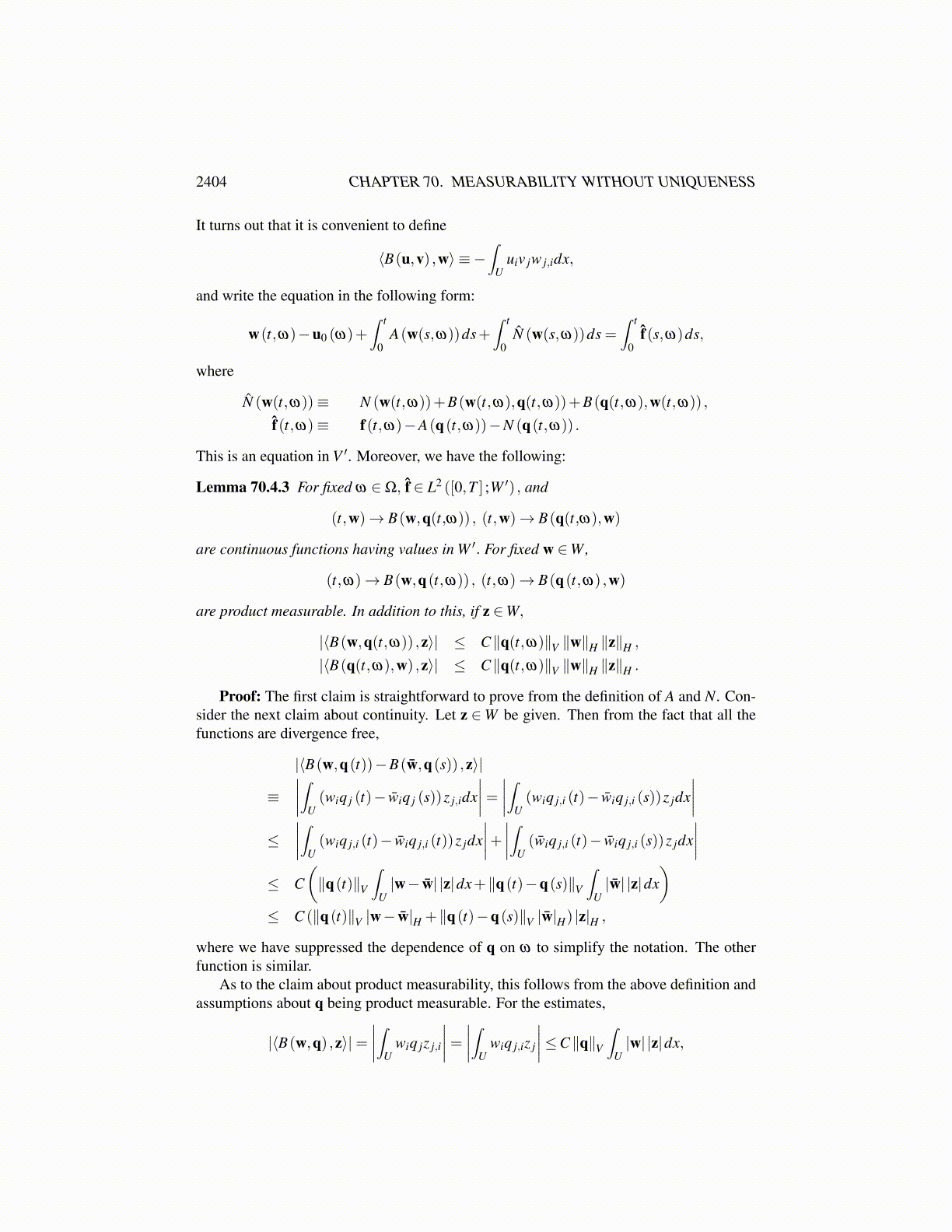
2404 CHAPTER 70. MEASURABILITY WITHOUT UNIQUENESS
is progressively measurable with respect to a constant filtration Ft = F . Also suppose(t,u,v,w)→ N(t,u,v,w,ω) is continuous. Suppose for each ω, there exists an estimatefor any solution u(·,ω) to the integral equation
u(t,ω)−u0(ω)+∫ t
0N(s,u(s,ω),u(s−h,ω) ,w(s,ω) ,ω)ds =
∫ t
0f(s,ω)ds, (70.3.5)
which is of the formsup
t∈[0,T ]|u(t,ω)| ≤C (ω)< ∞
Also let f be product measurable and f(·,ω) ∈ L1([0,T ] ;Rd
). Here u0 has values in Rd
and is F measurable and u(s−h,ω)≡ u0 (ω) whenever s−h≤ 0 and
w(t,ω)≡ w0 (ω)+∫ t
0u(s,ω)ds
where w0 is a given F measurable function. Then for h > 0, there exists a product mea-surable solution u to the integral equation 70.3.5.
Of course the same conclusions apply when there is no dependence in the integralequation on u(s−h,ω) or the integral w(t,ω). Note that these theorems hold for all ω .
70.4 The Navier−Stokes EquationsIn this section, we study the stochastic Navier−Stokes equations of arbitrary dimension.We prove there exists a global solution which is product measurable. The main result isTheorem 70.4.6. We use the Galerkin method and Theorem 70.3.3 to get product measur-able approximate solutions. Then we take weak limits and get path solutions. After this,we apply Theorem 70.2.8 to get product measurable global solutions.
As in [15], an important part of our argument is the theorem in Lions [91] which fol-lows. See Theorem 69.5.6.
Theorem 70.4.1 Let W, H, and V ′ be separable Banach spaces. Suppose W ⊆ H ⊆ V ′
where the injection map is continuous from H to V ′ and compact from W to H. Let q1 ≥ 1,q2 > 1, and define
S≡ {u ∈ Lq1 ([a,b] ;W ) : u′ ∈ Lq2([a,b] ;V ′
)and ||u||Lq1 ([a,b];W )+
∣∣∣∣u′∣∣∣∣Lq2 ([a,b];V ′) ≤ R}.
Then S is pre-compact in Lq1 ([a,b] ;H). This means that if {un}∞
n=1 ⊆ S, it has a subse-quence
{unk
}which converges in Lq1 ([a,b] ;H) .
A proof of a generalization of this theorem is found on Page 2387. Let U be a boundedopen set in Rd and let S denote the functions which are infinitely differentiable having zerodivergence and also having compact support in U . We have in mind d = 3, but the approachis not limited by dimension. We use the same Galerkin method found in [15], the detailsbeing included in slightly abbreviated form for convenience of the reader. The difference is